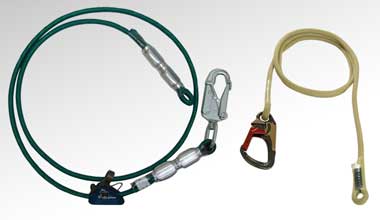Wirecore fliplines are about as traditional as you could get in tree work - BUT they might also become a thing of the past.
There are moves in a number of high-profile NZ arb companies to have wire core fliplines (positioning lanyards) relegated to the scrapheap. Some companies have already pronounced them dead and buried, banning the wire core flipline outright!
But every cloud has a silver lining and manufacturers are very quick to spot an opportunity.
Buckingham were first off the rank with the Buck Rigidline Lanyard, a synthetic alternative to its wire core brother.
The Buck Rigidline utilizes Yale Uniline, originally manufactured by Wall Rope Inc, a patented rope using parallel core yarns, bonded to each other including the braided polyester cover. The core carries the entire load and the cover serves to protect the core from abrasion.
The inner core is wrapped in red neoprene rubber which also serves as a wear indicator. Its primary purpose is to protect the core from moisture.
Uniline rope is very wire-core-like (if there is such a word).
That is, Uniline is almost impossible to knot. And a splice requires such a long bury it would not be practical on a lanyard, so Buckingham have opted for swaging, not unlike the construction of some traditional wire core lanyards.
The 'swaging' is the steel bulk you can see at each end of the lanyard on the left, in the picture below.
Another rope manufacturer to enter the wire core lanyard fray is Sterling Ropes, also from the US. They have come up with TriTech for positioning lanyard construction (when you don't want to use wire core).
Here's what the Sterling marketing gurus have to say about TriTech.
"TriTech is an 11mm rope designed with our unique Technora sheath, Dyneema inner jacket and nylon core".
"Sterling engineered this technically advanced rope specifically to produce the ultimate in positioning lanyards".
"By combining the abrasion resistant sheath over a cut-resistant and high strength inner jacket and pliable core, we have created a lanyard that is strong, and rugged, yet still supple enough to move and position easily".
"If you are looking for a rope alternative to a wire-core line, the TriTech offers the most cut resistance with non-conductive properties".
The tea-colored lanyard on the right, in the picture below, is made from Sterling TriTech.
The eyes are stitched and offer far less bulk than the swage on the Buckingham Rigidline. But TriTech may not be as stiff or as durable as Yale Unilne - only time will tell.
Treetools will have both samples of these wire core positioning lanyard alternatives available for appraisal over the next few weeks.
If you think wire core lanyards are a thing of the past, here is a chance to sample the future!

